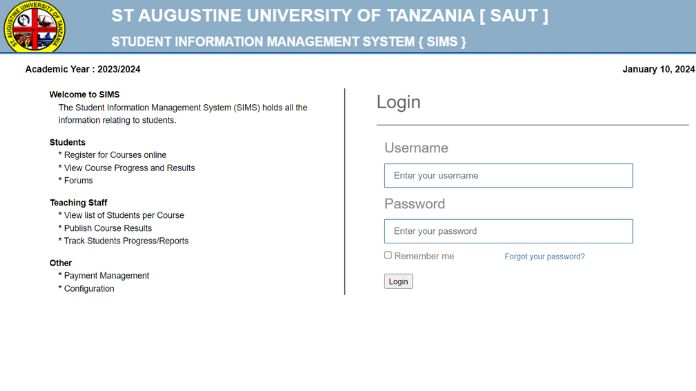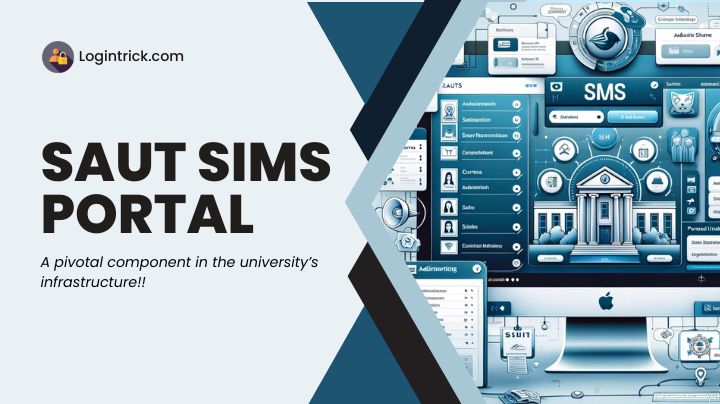The SAUT SIMS Portal is a pivotal component in the university’s infrastructure. This digital platform serves as a central repository for all academic-related information.
It is designed to streamline and automate a range of administrative and academic processes similar to MyCFCC and ARIS3 UDSM, intended to improve the educational experience of its thriving community.
Through SIMS, students can access their academic records, including grades and transcripts, register for courses, and manage their personal information.
Similarly, faculty members use the system for course management, grading, and monitoring student progress.
Importance of the SIMA Records, Registration, and Other Student Services
The significance of SAUT’s SIMS cannot be overstated when it comes to managing academic records and other student services.
This system plays a crucial role in:
- Academic Record Keeping: It maintains an accurate and up-to-date record of student grades, course completions, and academic progression. This ensures transparency and accessibility for students and faculty alike.
- Course Registration: SIMS simplifies the process of course registration, allowing students to enroll in classes online. This reduces administrative burden and improves efficiency.
- Streamlining Administrative Tasks: The system automates many administrative processes, reducing paperwork and minimizing the possibility of errors. This leads to a more efficient management of university resources.
- Enhanced Communication: SIMS facilitates better communication between students and faculty. Important announcements, schedule changes, and other academic notifications can be disseminated quickly and efficiently.
- Access to Educational Resources: Students can access various educational resources through the system, including online learning materials, which enhances their learning experience.
Benefits of SAUT SIMS Portal
The SAUT SIMS (Student Information Management System) at St. Augustine University of Tanzania offers a range of benefits to students and faculty, enhancing the educational experience and streamlining administrative processes.
Here are some of the key benefits:
For Students
- Easy Access to Academic Records: Students can view their grades, transcripts, and academic history anytime, which is crucial for monitoring their academic progress.
- Efficient Course Registration: The system simplifies the process of enrolling in courses, reducing the time and effort required compared to traditional methods.
- Real-Time Information: Updates on class schedules, examination dates, and important announcements are readily available, ensuring students are always informed.
- Convenient Fee Payment and Tracking: Students can pay fees through the system and track their payment history, making financial management more transparent and straightforward.
- Access to Learning Resources: The platform often provides links to learning materials, online resources, and other educational tools, supporting students’ academic growth.
For Faculty
- Streamlined Course Management: Faculty can manage course information, upload materials, and set assignments through the system, facilitating efficient course administration.
- Ease of Grading and Assessment: Teachers can submit grades and assess student performance directly within the system, making the grading process more efficient.
- Improved Student Monitoring: The system enables faculty to track student attendance, participation, and academic progress, aiding in the early identification of students who may need additional support.
- Effective Communication: Faculty can easily communicate with their students regarding course updates, feedback, and other important information.
For the University Administration
- Enhanced Administrative Efficiency: Automating administrative tasks like registration, record keeping, and reporting saves time and reduces errors.
- Data Management and Analysis: The system provides a centralized database for student information, allowing for better data management and analysis to inform decision-making.
- Compliance and Record Keeping: Maintaining accurate and up-to-date records is essential for institutional accreditation and compliance with educational standards.
- Resource Optimization: By reducing the reliance on paper-based processes and manual labor, the university can allocate resources more effectively.
How to Log In to SAUT SIMS Portal?

Accessing the SAUT SIMS (Student Information Management System) portal is straightforward.
Here’s a step-by-step guide to help students and faculty navigate the login procedure, including the requirements and first-time login instructions:
Step-by-Step Instructions on Accessing the SIMS Portal
- Open Your Web Browser: Launch your preferred web browser on your computer or mobile device.
- Visit the SAUT SIMS Portal: Go to the official SAUT SIMS website. The URL is typically provided by the university and is often found on SAUT’s main website or through direct communication from the university.
- Locate the Login Section: On the homepage of the SIMS portal, find the login section. This is usually prominently displayed.
- Enter Your Credentials: Input your student ID and password in the respective fields.
- Submit Your Login Details: Click on the login button to access your SIMS dashboard.
Requirements for Login
- Student ID: This is a unique identifier provided to you by the university. It’s often the same as your registration number or admission number.
- Password: The initial password is usually provided by the university or set up during the first-time account creation process.
First-Time Login Procedures and Setting Up an Account
- First-Time Access: When accessing SIMS for the first time, you might need to use a default password provided by the university. This information is often given during orientation or through an official university communication channel.
- Change Your Password: Upon first login, it’s advisable (and sometimes mandatory) to change your password. Choose a strong password that you can remember but is hard for others to guess.
- Update Your Profile: Fill in or update any necessary personal details in your profile. This may include contact information, next of kin details, and any other required data.
- Familiarize Yourself with the Dashboard: Take some time to explore the SIMS dashboard. Check out different sections like academic records, course registration, and financial information.
- Log Out Safely: Once you’ve completed your session, make sure to log out of the portal to maintain security.
Additional Tips
- Keep Your Credentials Secure: Never share your login details with anyone.
- Browser Compatibility: Ensure your browser is up to date for the best experience.
- Technical Issues: If you encounter any issues, contact the university’s IT support team for assistance.
Remember, the specifics of this process might vary slightly depending on the updates and changes made to the SAUT SIMS system. Always refer to the latest information provided by the university.
Security Features of SAUT SIMS
The SAUT SIMS (Student Information Management System) incorporates various security measures to ensure the protection of student data.
These measures are crucial in safeguarding personal and academic information from unauthorized access, misuse, or breaches.
Key security features include:
- Secure Login Authentication: The system requires a unique student ID and a password for access. This ensures that only authenticated users can access their accounts.
- Data Encryption: Sensitive data transmitted between the user’s device and the SIMS server is encrypted. This prevents interception or eavesdropping by unauthorized parties.
- Regular Security Updates: The SIMS software is regularly updated to address any security vulnerabilities and enhance its defense against new types of cyber threats.
- Firewalls and Intrusion Detection Systems: These are employed to monitor and control incoming and outgoing network traffic based on predetermined security rules, offering protection against attacks and unauthorized access.
- Access Controls and User Privileges: User access is controlled and restricted based on roles. Students, faculty, and administrators have different levels of access, ensuring users can only view or modify data that is relevant to their role.
- Data Backup and Recovery: Regular backups of the system data are conducted to prevent loss in case of hardware failure, natural disasters, or other incidents.
- Compliance with Privacy Laws: The system is designed to comply with relevant privacy laws and regulations, ensuring that the handling of student data meets legal standards.
Importance of Maintaining the Confidentiality of Login Credentials
Maintaining the confidentiality of login credentials in systems like SAUT SIMS is crucial for several reasons:
- Protecting Personal Information: Student accounts contain sensitive personal information, including contact details, academic records, and financial information. Keeping login credentials confidential helps protect this data from unauthorized access.
- Preventing Academic Misconduct: Unauthorized access to a student’s account could lead to academic misconduct, such as altering grades or enrolling in courses without consent.
- Avoiding Identity Theft: If login credentials are compromised, it could lead to identity theft, where the perpetrator could impersonate the student for fraudulent purposes.
- Maintaining System Integrity: Secure credentials help maintain the overall integrity of the SIMS. Compromised accounts can be used to disrupt the system’s operations, affecting many users.
- Legal and Compliance Reasons: Adhering to privacy policies and regulations is a legal obligation. Students are often required to keep their credentials confidential as part of the terms of use for educational systems.
To ensure the confidentiality of login credentials, students and faculty should:
- Create strong, unique passwords and change them regularly.
- Avoid sharing passwords with others.
- Be cautious of phishing attempts and suspicious emails requesting login information.
- Log out of the system when finished, especially when using public or shared computers.
By understanding and adhering to these security measures and best practices, students and faculty can significantly contribute to the protection of personal and institutional data within the SAUT SIMS environment.
Summing Up!
In summary, the SAUT SIMS (Student Information Management System) is a pivotal resource at St. Augustine University of Tanzania, designed to streamline and enhance the educational experience for both students and faculty.
The importance of maintaining the confidentiality of login credentials cannot be overstressed. It is a critical aspect of preserving the integrity and security of personal and academic information within the system.
As we look at the broader picture, it’s evident that SAUT SIMS is more than just a tool for managing academic records and administrative tasks. It’s a gateway to academic success and a more organized university experience. Students and faculty are encouraged to fully utilize this portal, not just as a requirement but as a powerful ally in their educational journey.
The ease of access to information, combined with the efficiency it brings to academic and administrative procedures, empowers users to focus more on the core aspects of learning and teaching.
